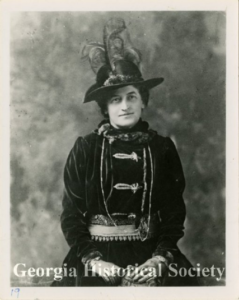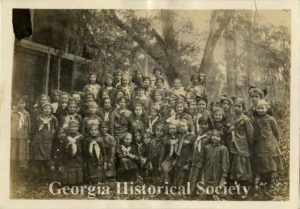By Rachael Zipperer

“Daisy Low”
A Georgian began what would become the largest voluntary organization for women and girls in the United States. Inspired by Sir Robert Baden-Powell’s Boy Scouts and Girl Guides in Britain, Juliette Gordon Low founded the American Girl Guides (later renamed the Girl Scouts) in 1912.
Low’s correspondence with Baden-Powell and others (housed at the Georgia Historical Society (GHS) and available online through the Digital Library of Georgia and Digital Public Library of America) shows the goals Low had for her new organization: to be practical while still enticing to girls, and to instill in girls a foundation of strength and good moral character.
These founding principles are evident in the first Girl Scout Handbook. How Girls Can Help Their Country, the original 1917 document, is in GHS’s Rare Pamphlet Collection or can be viewed online through Project Gutenberg. Never mentioning cookie sales, the handbook describes the tenets of the organization and all aspects of being a girl scout. In addition to Girl Scout Laws and membership rules are suggestions of good deeds to perform daily, rules of games and sports, first aid techniques, and instructions for how to camp outdoors, communicate with Morse Code, and tie knots. This useful information could help a scout earn merit badges from the “housekeeper” badge to the “marksmanship” badge.

Girl Scouts of Savannah with their founder, Juliette Gordon Low (MS 403-01-01-008), Walter John Hoxie Papers
By the time of Low’s death in 1927, the organization had grown from the original troop of 18 girls in Savannah, Georgia to 168,000 members. Currently, the Girl Scouts has 2.7 million members across the nation. While the organization has seen incredible growth since its founding more than 100 years ago, the Girl Scouts continues to build courage, confidence, and character in girls; and their slogan remains the same: “Do a good turn daily.”
Visit the GHS digital exhibit to learn more about this innovator’s life and the Girl Scouts. Other GHS resources include the Anne Mintz Collection of Girl Scouts Troop 1 Records (MS 2351) and Walter John Hoxie Papers (MS 403).
